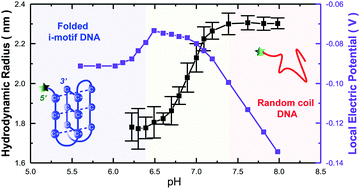Charge evolution during the unfolding of a single DNA i-motif†
Abstract
The effective charge and evolution of single chains of a DNA i-motif during its unfolding process are investigated at the single molecule level. Using fluorescence correlation spectroscopy and photon counting histograms, the single chain dimensions and electrical potential of cytosine-rich human telomeric oligonucleotides are monitored, during their unfolding from the i-motif to the random coil state. It is discovered that the effective charge density of the DNA chain is very sensitive to conformation changes and the results remarkably expose the existence of an intermediate state of the unfolding process. A huge difference in pH value exists in the vicinity of the DNA chain and the bulk solution, depending on the salt concentration, as reflected by a down-shift in the pH value of unfolding. The presence of an external salt in the solution helps to stabilize the i-motif structure at low pH values due to the reduction of the effective charge density. It can also destabilize the folded structure in the pH range of the conformation transition due to the elevation of the local pH value, encouraging the deprotonation of the cytosine groups. These results provide new information for understanding the structure and stability of i-motif DNA, and its biological function, as well as the building blocks for smart nanomaterials.



 Please wait while we load your content...
Please wait while we load your content...